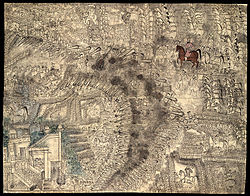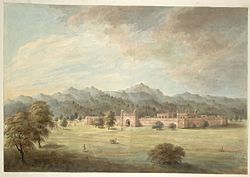Najib ad-Dawlah
Najib ad-Dawlah | |
|---|---|
| Nawab Capture of Agra Fort |

Najib ad-Dawlah (
He began his career in 1743 as an immigrant from Manri kohistan as a soldier. He was an employee of
Biography
Najib Khan belonged to the Umar Khel section of the


Imad-ul-Mulk appointed Najib ad- Dawlah as the governor of
Conflict with Marathas
Battle of Delhi (1757)
Third Battle of Panipat
In the
After the war, he was made
Najib Khan was a
This territory thus became in its turn separated from the Empire and continued for two generations in the family of Najib. He ruled the dwindled Empire for nine years, and died a peaceful death, leaving his charge in an improved and strengthened condition, ready for its lawful monarch.[citation needed]
Administrator of Delhi
As the Administrator of
Death
After protecting Rohilkhand, Delhi and Agra for nearly ten years as regent of the Mughal Empire, he fell ill and died on 30 October 1770.[15]
Successor
After his death he was succeeded by his son
Destruction of his tomb by the Marathas
His son
A few years later, in the subsequent
In popular culture
- In the 1994 Hindi TV series The Great Maratha, Najib's character was portrayed by Irrfan Khan.
- In the 2019 , appears as one of the primary antagonists.
See also
Further reading
- Najib-ud-Daula at Dehli The Fall of the Moghul Empire of Hindustan, by H. G. Keene. 1887, Part II, Chapter II, 1764.
- The Fall of the Mughal Empire by Jadunath Sarkar
☆ Azad Patan Qabayel by Allabakhash Yousafi. ☆ Yousafzai Sardar Awr Hukamraan, Prof.Bakhtiar, Arshad Publishers, Swabi, 2012.
References
- ^ History of Etawah Etawah Official website.
- ^ Chisholm, Hugh, ed. (1911). . Encyclopædia Britannica. Vol. 19 (11th ed.). Cambridge University Press. p. 156..
- ^ Hamid Afaq Qureshi · (2003). The Mughals, the English & the Rulers of Awadh, from 1722 A.D. to 1856 A.D.: A Kaleidoscopic Study. p. 51.
He belonged to the Umar Khail Yusufzai tribe of the Afghans and was a resident of Manri.
- ^ Nuruddin Husain (1952). An Account of Najibuddaulah. p. LIII.
in the year 1708 in the village of Manri about 25 kos from Peshawar.
- ^ a b History of Bijnor District The Imperial Gazetteer of India, 1909, v. 8, p. 194-195.
- ^ ISBN 9788180903397Bharatiya Kala Prakashan
- ^ [1] p. 57
- ^ Jaswant Lal Mehta (2005). Advanced Study in the History of Modern India 1707-1813. p. 230.
- ^ Hari Ram Gupta (1999). History of the Sikhs. p. 339.
- ^ Hari Ram Gupta (1961). Marathas and Panipat. Panjab University.
Qutb Shah Rohilla, Najib's religious precept
- ^ Advanced Study in the History of Modern India 1707-1813
- ^ Najibabad Tehsil & Town The Imperial Gazetteer of India, 1909, v. 18, p. 334.
- ^ History of Modern India, 1707 A. D. to 2000 A. D
- ^ "MANAS | UCLA Social Sciences Computing". Archived from the original on 6 October 1999.
- ^ Rule of Shah Alam, 1759-1806 The Imperial Gazetteer of India, 1909, v. 2, p. 411.
- ^ Altaf Ali Brelvi (1966). Life of Hafiz Rahmat Khan. p. 174.
- ^ Chisholm, Hugh, ed. (1911). . Encyclopædia Britannica. Vol. 3 (11th ed.). Cambridge University Press. p. 928.
- ISBN 9788185431529.
